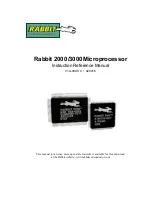
823
11054A–ATARM–27-Jul-11
SAM9X25
823
11054A–ATARM–27-Jul-11
SAM9X25
Figure 39-27.
Connection with a Remote Device for Hardware Handshaking
Setting the USART to operate with hardware handshaking is performed by writing the
USART_MODE field in the Mode Register (US_MR) to the value 0x2.
The USART behavior when hardware handshaking is enabled is the same as the behavior in
standard synchronous or asynchronous mode, except that the receiver drives the RTS pin as
described below and the level on the CTS pin modifies the behavior of the transmitter as
described below. Using this mode requires using the DMAC channel for reception. The transmit-
ter can handle hardware handshaking in any case.
shows how the transmitter operates if hardware handshaking is enabled. The CTS
pin disables the transmitter. If a character is being processing, the transmitter is disabled only
after the completion of the current character and transmission of the next character happens as
soon as the pin CTS falls.
Figure 39-28.
Transmitter Behavior when Operating with Hardware Handshaking
39.7.4
ISO7816 Mode
The USART features an ISO7816-compatible operating mode. This mode permits interfacing
with smart cards and Security Access Modules (SAM) communicating through an ISO7816 link.
Both T = 0 and T = 1 protocols defined by the ISO7816 specification are supported.
Setting the USART in ISO7816 mode is performed by writing the USART_MODE field in the
Mode Register (US_MR) to the value 0x4 for protocol T = 0 and to the value 0x5 for protocol T =
1.
39.7.4.1
ISO7816 Mode Overview
The ISO7816 is a half duplex communication on only one bidirectional line. The baud rate is
determined by a division of the clock provided to the remote device (see
The USART connects to a smart card as shown in
. The TXD line becomes bidirec-
tional and the Baud Rate Generator feeds the ISO7816 clock on the SCK pin. As the TXD pin
becomes bidirectional, its output remains driven by the output of the transmitter but only when
the transmitter is active while its input is directed to the input of the receiver. The USART is con-
sidered as the master of the communication as it generates the clock.
USART
TXD
CTS
Remote
Device
RXD
TXD
RXD
RTS
RTS
CTS
CTS
TXD
Summary of Contents for SAM9X25
Page 26: ...26 11054A ATARM 27 Jul 11 SAM9X25...
Page 138: ...138 11054A ATARM 27 Jul 11 SAM9X25 138 11054A ATARM 27 Jul 11 SAM9X25...
Page 162: ...162 11054A ATARM 27 Jul 11 SAM9X25 162 11054A ATARM 27 Jul 11 SAM9X25...
Page 216: ...216 11054A ATARM 27 Jul 11 SAM9X25 216 11054A ATARM 27 Jul 11 SAM9X25...
Page 266: ...266 11054A ATARM 27 Jul 11 SAM9X25 266 11054A ATARM 27 Jul 11 SAM9X25...
Page 330: ...330 11054A ATARM 27 Jul 11 SAM9X25 330 11054A ATARM 27 Jul 11 SAM9X25...
Page 374: ...374 11054A ATARM 27 Jul 11 SAM9X25...
Page 468: ...468 11054A ATARM 27 Jul 11 SAM9X25 468 11054A ATARM 27 Jul 11 SAM9X25...
Page 532: ...532 11054A ATARM 27 Jul 11 SAM9X25 532 11054A ATARM 27 Jul 11 SAM9X25...
Page 692: ...692 11054A ATARM 27 Jul 11 SAM9X25 692 11054A ATARM 27 Jul 11 SAM9X25...
Page 777: ...777 11054A ATARM 27 Jul 11 SAM9X25 777 11054A ATARM 27 Jul 11 SAM9X25...
Page 886: ...886 11054A ATARM 27 Jul 11 SAM9X25 886 11054A ATARM 27 Jul 11 SAM9X25...
Page 962: ...962 11054A ATARM 27 Jul 11 SAM9X25 962 11054A ATARM 27 Jul 11 SAM9X25...
Page 1036: ...1036 11054A ATARM 27 Jul 11 SAM9X25 1036 11054A ATARM 27 Jul 11 SAM9X25...
Page 1128: ...1128 11054A ATARM 27 Jul 11 SAM9X25 1128 11054A ATARM 27 Jul 11 SAM9X25...
Page 1130: ...1130 11054A ATARM 27 Jul 11 SAM9X25...
Page 1132: ...1132 11054A ATARM 27 Jul 11 SAM9X25...
Page 1144: ...xii 11054A ATARM 27 Jul 11 SAM9X25...
















































